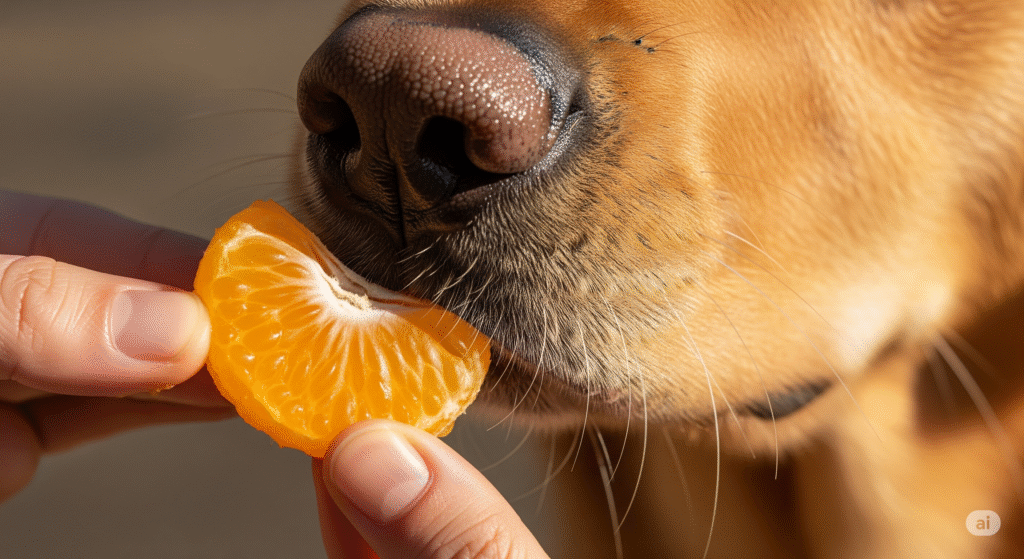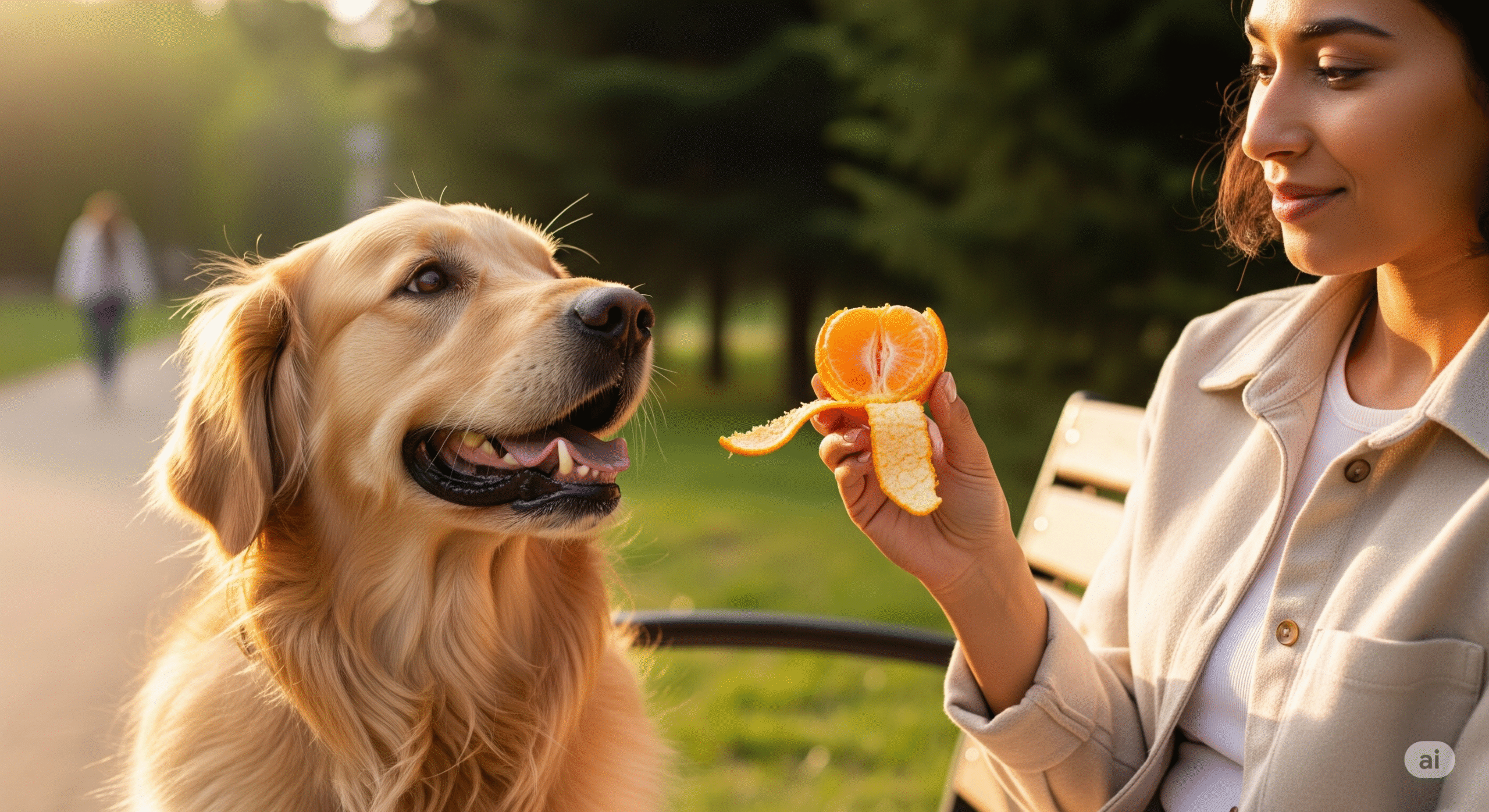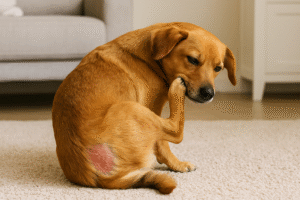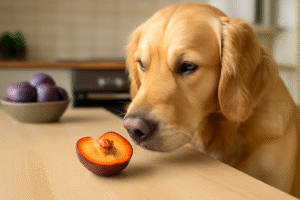Medical Disclaimer: Please note: This article provides general veterinary information and is not a substitute for professional medical advice. Always consult your veterinarian for any health concerns or before making changes to your pet’s diet.
Table of Contents
Introduction
That moment when you’re enjoying a juicy orange, and your furry friend gives you “the look”—you know, the one that asks, Can I have some too? As a vet in Ottawa, I get this question a lot. It’s sweet, it’s refreshing, but are dog oranges a safe snack for our canine companions? The good news is, yes, in moderation, the fleshy part of oranges can be a safe treat for most dogs. However, there are some really important things you need to know about portion sizes, potential risks, and how to prepare them properly to keep your pup happy and healthy. Let’s dive into the world of dog oranges together!
Key Takeaways
- Moderation is Key: Only feed dog oranges in small amounts; they’re treats, not a meal.
- Prepare Safely: Always remove the peel, seeds, and pith before offering any orange flesh to your dog.
- Watch for Reactions: Some dogs have sensitive stomachs and might experience digestive upset from oranges.
- Avoid for Certain Conditions: If your dog has diabetes, is overweight, or has a sensitive stomach, it’s best to skip oranges.
- Health Benefits: Oranges offer a boost of Vitamin C, fiber, and antioxidants, but dogs produce their own Vitamin C.
- Better Alternatives: Many other fruits and veggies are safer and lower in sugar for dogs, like blueberries and carrots.
Can Dogs Really Eat Oranges? My Vet Perspective
As a veterinarian with years of experience, I’ve seen countless pet parents wonder about sharing their food. When it comes to dog oranges, the short answer is generally yes, but with a big emphasis on moderation and proper preparation. Think of them as a tiny, occasional treat, not a regular snack.
While oranges aren’t toxic to dogs, it’s not a food that’s essential for their diet. Dogs naturally produce their own vitamin C, so they don’t need oranges for that nutrient, unlike us humans. However, a small segment can offer some benefits and a fun, new flavour experience for your pup.
I often tell my clients that the main fleshy part of an orange is what you want to focus on. Just like when I’m at home and my own dog gives me those puppy-dog eyes, I’ll sometimes share a tiny, peeled, seedless segment. It’s a moment of bonding, and as long as it’s a small amount, it’s usually fine. However, parts like the peel and seeds are definite no-gos due to potential digestive upset or even a risk of blockage, especially in smaller breeds. The Pet Poison Helpline also cautions against ingesting the essential oils found in citrus peels, which can cause gastrointestinal upset.
The key is to introduce any new food slowly and observe your dog’s reaction. Every dog is an individual, and what one dog tolerates perfectly, another might find a bit too acidic or sugary.
Can Dogs Really Eat Oranges? My Vet Perspective
As a veterinarian with years of experience, I’ve seen countless pet parents wonder about sharing their food. When it comes to dog oranges, the short answer is generally yes, but with a big emphasis on moderation and proper preparation. Think of them as a tiny, occasional treat, not a regular snack.
While oranges aren’t toxic to dogs, it’s not a food that’s essential for their diet. Dogs naturally produce their own vitamin C, so they don’t need oranges for that nutrient, unlike us humans. However, a small segment can offer some benefits and a fun, new flavour experience for your pup.
I often tell my clients that the main fleshy part of an orange is what you want to focus on. Just like when I’m at home and my own dog gives me those puppy-dog eyes, I’ll sometimes share a tiny, peeled, seedless segment. It’s a moment of bonding, and as long as it’s a small amount, it’s usually fine. However, parts like the peel and seeds are definite no-gos due to potential digestive upset or even a risk of blockage, especially in smaller breeds. The Pet Poison Helpline also cautions against ingesting the essential oils found in citrus peels, which can cause gastrointestinal upset.
The key is to introduce any new food slowly and observe your dog’s reaction. Every dog is an individual, and what one dog tolerates perfectly, another might find a bit too acidic or sugary.

The Sweet Truth: Nutritional Benefits of Oranges for Dogs
While dog oranges aren’t a dietary necessity, they do pack a small nutritional punch that can be beneficial when offered in appropriate, tiny amounts. Think of it as a little bonus, not a core food group.
Vitamin C Boost: More Than Just for Humans
We all know oranges are famous for vitamin C, and while dogs can produce their own, supplemental intake from fresh fruits can still play a role. This antioxidant vitamin is important for immune function and can help reduce inflammation, particularly in stressed or aging dogs. While the AKC Canine Health Foundation notes that healthy dogs synthesize their own vitamin C, there’s no harm in a little extra from a safe, whole food source.
Fiber for a Happy Gut
The natural fiber found in orange flesh can be good for your dog’s digestion. Just like in humans, fiber helps regulate bowel movements, which can prevent constipation and support overall gut health. However, too much fiber too quickly can have the opposite effect – nobody wants a case of doggy diarrhea! This is another reason why small amounts of dog oranges are key.
Antioxidants & Potassium: Small Fruit, Big Impact
Beyond vitamin C, oranges contain other antioxidants that help protect cells from damage caused by free radicals. This can potentially lower the risk of chronic diseases over time. They also offer potassium, an important electrolyte that supports proper nerve function and muscle health in dogs.
Hydration Help (But Water is Still King!)
With their high water content, oranges can contribute a little bit to your dog’s hydration, especially on a warm day. However, it’s crucial to remember that fresh, clean water should always be your dog’s primary source of hydration. An orange segment is a tiny sip, not a drink replacement!
Ultimately, if your dog enjoys the taste and tolerates them well, a small piece of dog oranges can be a refreshing and somewhat nutritious, low-calorie treat. But let’s balance that with understanding the potential downsides before you offer them freely.

Zest for Caution: Risks and Dangers of Oranges for Dogs
While the idea of sharing dog oranges might seem appealing, it’s crucial to understand that they come with potential downsides, especially if not given properly or in excess. As a vet, I’ve often seen well-meaning owners accidentally cause tummy troubles by overdoing it with human foods.
The Sugar Conundrum: A Treat, Not a Staple
Oranges are naturally sweet, which makes them tasty for us, but for dogs, this sweetness means a notable sugar content. High sugar intake in dogs can lead to several problems:
- Digestive upset: This often manifests as gas, bloating, or diarrhea.
- Weight gain: Frequent sugary treats contribute to obesity, a growing concern in our pet population.
- Blood sugar spikes: This is particularly dangerous for diabetic dogs, for whom even a small amount can throw their blood sugar levels out of whack. If your dog has diabetes, it’s best to avoid dog oranges altogether and discuss safe treats with your veterinarian.
Digestive Upset: Every Dog is Different
Not all dogs can handle citrus. Some may experience mild stomach upset even from a small piece, especially if they’re new to fruits or have a generally sensitive digestive system. When I discuss new foods with clients, I always advise watching for signs like vomiting, diarrhea, or excessive drooling, which could indicate irritation. If your dog shows any of these symptoms after eating dog oranges, stop offering them immediately.
The “No-Go” Parts: Peels, Seeds, and Pith
This is perhaps the most important point when considering dog oranges. While the flesh is generally safe, other parts are not:
- Orange Peels: These are tough, fibrous, and very difficult for a dog to digest. They can cause significant gastrointestinal upset or, worse, an intestinal blockage, which can be a serious veterinary emergency.
- Seeds: Orange seeds contain trace amounts of cyanide. While a single seed is unlikely to cause harm, the cumulative effect of many seeds, especially for a small dog, is best avoided. It’s always safest to remove them.
- White Pith: This stringy, bitter part found under the peel can also cause stomach irritation and is best removed.
My advice? Always peel the orange thoroughly, remove all seeds, and only offer small, bite-sized pieces of the juicy flesh. This simple preparation drastically reduces the risks associated with dog oranges.
Can a dog eat Plums? You can find information here
Serving Oranges Safely: A Step-by-Step Guide
If you’ve decided to offer your dog a bit of orange, doing it correctly is vital to avoid any issues. As with any new treat, I always tell my clients to start small and observe. It’s better to be overly cautious when introducing new foods, especially with dog oranges.
Preparation is Key: Peel, Seed, and Portion
This is the most crucial step. You should only offer the fleshy, juicy part of the orange.
- Peel It Completely: Remove every bit of the outer peel. It’s tough, hard to digest, and contains essential oils that can irritate your dog’s stomach.
- Remove All Seeds: While a single seed isn’t likely toxic, it’s safer to remove them entirely, especially since they contain trace amounts of cyanide.
- Discard the Pith: That white, stringy material clinging to the segments? Take it off. It’s bitter and can cause stomach upset.
- Cut into Small, Bite-Sized Pieces: Even for large dogs, small segments are best. This prevents choking hazards and makes digestion easier. For my own Labrador, even a single segment gets broken into two or three pieces.

How Much is Too Much? Portion Control for Pups
Dog oranges should be an occasional treat, not a regular snack. Think of it as a special surprise, not a dietary staple. A good rule of thumb I share with pet parents is to keep treats, including oranges, to 10% or less of your dog’s total daily caloric intake.
Here are general guidelines:
- Small Dogs (e.g., Chihuahuas, Pugs): 1 small segment per week, maximum.
- Medium Dogs (e.g., Beagles, Corgis): 1-2 small segments per week, maximum.
- Large Dogs (e.g., Labradors, German Shepherds): 2-3 small segments per week, maximum.
Always start with the smallest amount to see how your dog reacts.
Creative Ways to Serve Orange Segments
If your dog enjoys the taste and handles them well, you can get a little creative:
- Fresh & Peeled: The simplest and safest option.
- Frozen Orange Pieces: A refreshing, cooling treat on a hot summer day in Ottawa! Just make sure they’re small enough not to be a choking hazard.
- Mashed & Mixed: A tiny bit of mashed orange flesh can be mixed into their regular kibble for a burst of flavour.
What to Avoid:
- Orange Juice: Too concentrated in sugar and lacks the beneficial fiber.
- Canned Oranges: These often contain added sugars and preservatives that aren’t good for dogs.
- Dried Oranges: The sugar content becomes very concentrated, making them less ideal.
5-Minute Home Checklist: Orange Prep
Here’s a quick guide to safely prepare dog oranges for your furry friend:
- Gather: One fresh orange, a small knife, and a clean cutting board.
- Peel: Remove all orange peel, ensuring no white pith remains.
- Segment: Separate the orange into individual segments.
- Deseed: Carefully check each segment and remove all seeds.
- Chop: Cut each segment into small, bite-sized pieces appropriate for your dog’s size.
- Serve: Offer a small piece.
- Store/Discard: Store any remaining prepared orange in the fridge for a day or two, or discard.
When Oranges are a “No”: Special Health Considerations
While dog oranges can be a safe treat for many pups, there are specific situations where they should be avoided entirely. As a vet, I always advise caution, especially when a dog has underlying health issues. It’s truly better to be safe than sorry.
Diabetic Dogs: A Sweet Risk
For dogs with diabetes, oranges pose a significant risk. Their natural sugars can cause dangerous spikes in blood glucose levels, making it very difficult to manage their condition. Even a small piece could lead to complications. My firm recommendation for diabetic dogs is to steer clear of dog oranges and any other sugary fruits. Instead, consult your veterinarian for safe, low-sugar treat alternatives that won’t disrupt their carefully balanced diet and medication.
Overweight Dogs: Calories Add Up
Obesity is a serious health concern in dogs, leading to issues like joint pain, heart disease, and a shortened lifespan. While oranges are low in fat, they still contain calories and sugar. If your dog is on a weight management plan, those extra calories from frequent dog oranges can quickly add up and hinder their progress. In these cases, it’s best to opt for truly low-calorie, high-fiber treats like plain green beans or cucumber slices.
Sensitive Stomachs: Listen to Your Dog’s Gut
Some dogs simply don’t tolerate citrus well. The acidity in oranges, even in small amounts, can upset a sensitive digestive system. I’ve seen dogs with a history of vomiting, diarrhea, or general food sensitivities react poorly to even tiny bits of orange.
Signs Your Dog Isn’t Tolerating Oranges Well:
- Loose stools or diarrhea
- Excessive drooling
- Signs of stomach discomfort (such as whining, pacing, or excessive gas)
- Vomiting
If you notice any of these signs after giving your dog dog oranges, stop immediately. Offering plain water can help flush their system, and if symptoms persist, it’s time for a call to your vet.
Dogs with Citrus Sensitivities
Beyond just a sensitive stomach, some dogs might have a specific sensitivity to the compounds or essential oils found in citrus fruits. While not common, this can cause mild mouth irritation, excessive drooling, or general discomfort. If you’ve never offered your dog any citrus before, start with an extremely tiny bite and wait several hours to observe for any adverse reactions before offering more. This cautious approach is key to safely introducing any new food into your dog’s diet.
My Dog Ate Too Many Oranges! What to Do
It happens to the best of us. You turn your back for a moment, and your resourceful pup manages to snatch an entire orange off the counter. Or maybe you just misjudged the “moderation” part. Should you panic? Here’s what to do if your dog overindulges in dog oranges.
Assessing the Situation: Quantity and Parts Eaten
First, try to gauge how much they ate and what parts.
- One or two small segments? Your dog is likely fine, but keep a close eye on them for the next 12-24 hours.
- An entire orange (or more)? This increases the likelihood of digestive upset due to the high sugar and acidity.
- Did they eat the peel or seeds? This is a bigger concern. Orange peels are difficult to digest and can lead to intestinal blockage, particularly in smaller dogs. Seeds contain trace amounts of cyanide, which is best avoided.

Symptoms to Watch For
If your dog has eaten too many dog oranges, you might observe some of these signs of stomach upset:
- Diarrhea or loose stools
- Vomiting
- Bloating or excessive gas
- Lethargy or decreased energy
- Excessive drooling (which can indicate mouth irritation from citric acid)
- Paw-licking or lip-smacking (often signs of nausea)
Home Care for Mild Upset
For mild symptoms like soft stools or a bit of gas, you can usually manage at home:
- Provide Plenty of Water: Encourage your dog to drink water to help flush out excess sugar and acid.
- Bland Diet: For the next 24-48 hours, offer a bland diet. This typically means plain boiled white rice mixed with lean, skinless boiled chicken breast (about a 2:1 ratio of rice to chicken). This can help soothe their digestive system.
- Withhold Treats: Don’t offer any more treats, including dog oranges or other fruits, until their stomach settles.
When to Call Your Veterinarian
While most cases of mild overconsumption resolve on their own, there are times when immediate veterinary attention is needed. You should seek veterinary advice if:
- Symptoms last longer than 24 hours.
- Your dog is repeatedly vomiting or has severe, watery diarrhea.
- Your dog seems lethargic, weak, or refuses to eat or drink for an extended period.
- You notice signs of a potential intestinal blockage, such as repeated unproductive vomiting (retching without producing anything), extreme abdominal bloating, or straining to defecate without success. This is especially critical if you know they ate the peel.
As a general practitioner, I always tell pet parents that if you’re ever in doubt or worried, don’t hesitate to call your vet. We’re here to help, and catching issues early is always best. To prevent future mishaps, make sure any accessible dog oranges or other human foods are stored in dog-proof containers or out of reach!
Healthier Alternatives: Vet-Approved Fruits & Veggies
If you’re looking for dog-friendly snacks that offer similar nutritional benefits to dog oranges but with fewer risks, or just generally healthier options, there are plenty of excellent choices! As a Canadian vet, I often recommend these to my clients, as they’re widely available and generally well-tolerated.
Top Fruit Choices for Dogs
Many fruits are fantastic, low-calorie treats for dogs, offering vitamins, minerals, and fiber without the high sugar or acidity concerns of oranges:
- Apples (Seedless & Peeled): A wonderfully crunchy treat rich in fiber and vitamins A and C. Always remove the core and seeds, as apple seeds contain cyanide.
- Blueberries: These tiny powerhouses are packed with antioxidants and are naturally low in sugar. They’re a fantastic, bite-sized reward.
- Strawberries: Another great source of vitamin C and antioxidants, with a slightly lower sugar content than oranges.
- Watermelon (Seedless & Rind-Free): Extremely hydrating and refreshing, especially on a hot summer day here in Ottawa! Be sure to remove all seeds and the hard rind, which can cause digestive upset.
- Bananas: A good source of potassium and vitamins, but they are relatively high in sugar, so offer only in small, occasional pieces.
Excellent Veggie Options
Vegetables are often even better choices than fruits for daily treats, as they are typically much lower in sugar and calories, while still providing essential nutrients and fiber.
- Cucumbers: Almost entirely water, making them an excellent, virtually calorie-free hydrating snack. Great for dogs on a weight-loss plan.
- Carrots: Crunchy, sweet, and excellent for dental health, carrots are a favourite for many dogs. They’re full of beta-carotene.
- Green Beans (Plain & Unsalted): A super low-calorie option that’s full of vitamins and fiber. Make sure they’re plain—no salt, butter, or spices!
Best Practice for New Treats
Always introduce any new treat, whether it’s a fruit or vegetable, in small amounts first. Monitor your dog for any signs of digestive upset, just as you would with dog oranges. If you’re ever unsure about a specific food, or if your dog has any existing health conditions or dietary sensitivities, always have a chat with your veterinarian. They can provide personalized recommendations tailored to your dog’s unique needs.
Frequently Asked Questions About Dogs and Oranges
Here are some of the most common questions dog owners, including my own clients, ask about feeding dog oranges to their pups.
Q1: Can all dogs eat oranges?
Most healthy dogs can eat small amounts of orange flesh safely. However, dogs with diabetes, obesity, or sensitive stomachs should generally avoid oranges due to their sugar and acidity. It’s always best to err on the side of caution.
Q2: How much orange can I give my dog?
For small dogs (like Chihuahuas), 1 small segment per week. For medium dogs (like Beagles), 1-2 small segments per week. For large dogs (like Labradors), 2-3 small segments per week. Remember, treats, including dog oranges, should not exceed 10% of your dog’s daily calorie intake.
Q3: Can dogs eat orange peels?
No, absolutely not. Orange peels are tough to digest and can cause intestinal blockages, especially in smaller dogs. They also contain essential oils that may irritate your dog’s stomach. Always remove the peel before feeding any dog oranges.
Q4: What about orange seeds? Are they dangerous?
Yes, orange seeds contain trace amounts of cyanide, similar to apple seeds. While a couple of seeds are unlikely to cause severe harm, it’s always best practice to remove all seeds before offering dog oranges to your pet to eliminate any risk.
Q5: Can puppies eat oranges?
It’s generally best to avoid feeding oranges to puppies. Their digestive systems are much more sensitive than adult dogs, and introducing new or acidic foods like dog oranges could easily cause an upset stomach. Stick to puppy-specific treats and foods.
Q6: Can dogs eat mandarin oranges, tangerines, or clementines?
Yes, but in moderation, just like regular oranges. These fruits are often slightly sweeter and thus contain a bit more sugar, so portion control is even more important. Always peel and remove any seeds.
Q7: Can dogs drink orange juice?
No. Orange juice is too concentrated, high in sugar, and acidic for dogs. Even fresh-squeezed juice lacks the beneficial fiber of whole oranges and can cause digestive upset. Stick to fresh, peeled dog oranges if you’re going to offer them.
Q8: My dog ate a whole orange—should I be worried?
Monitor your dog closely for signs of stomach upset, including vomiting, diarrhea, or bloating. If they ate the peel or a significant number of seeds, you should definitely call your veterinarian, as these can pose a risk of obstruction or toxicity. Prompt action can prevent more serious issues.




